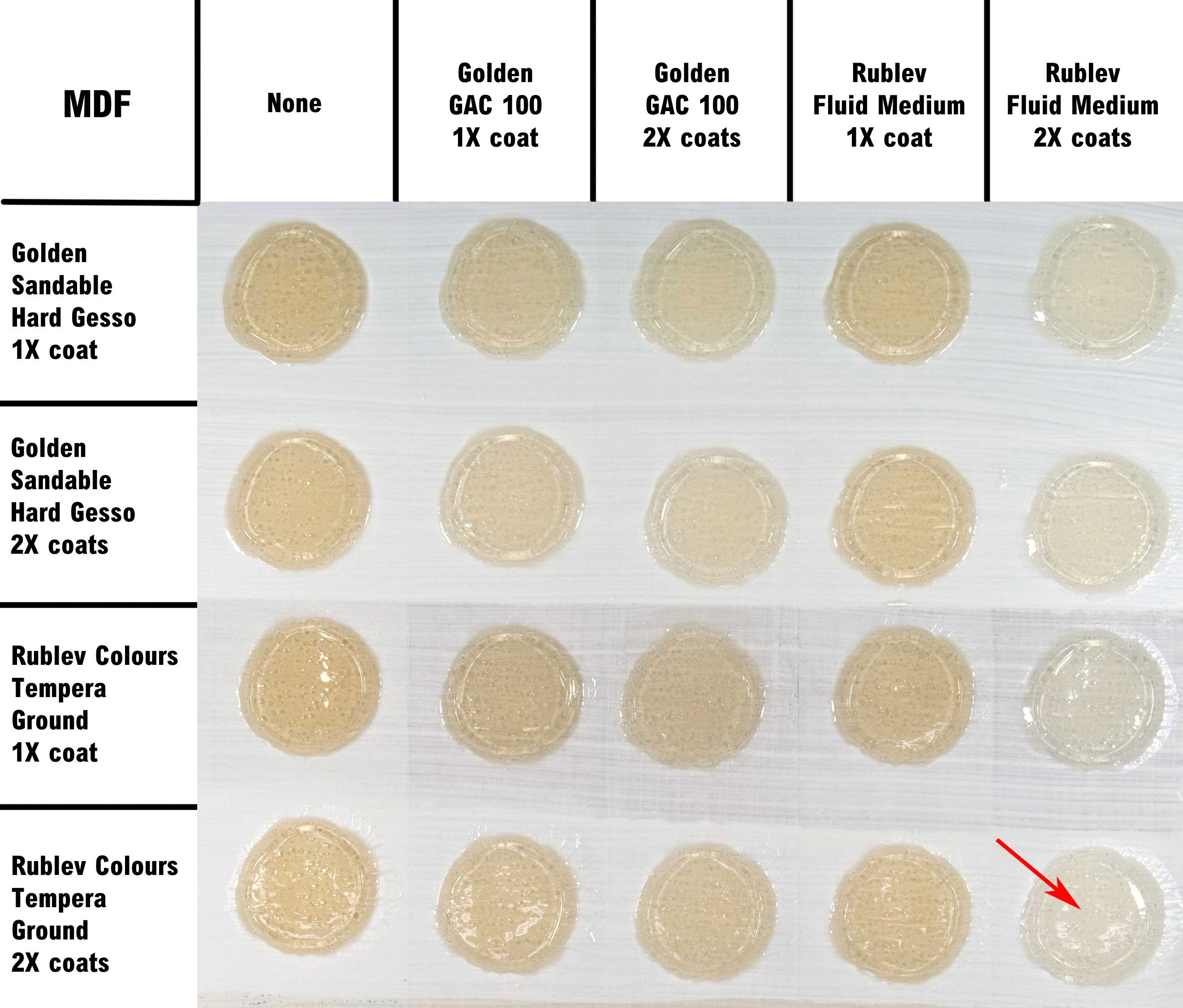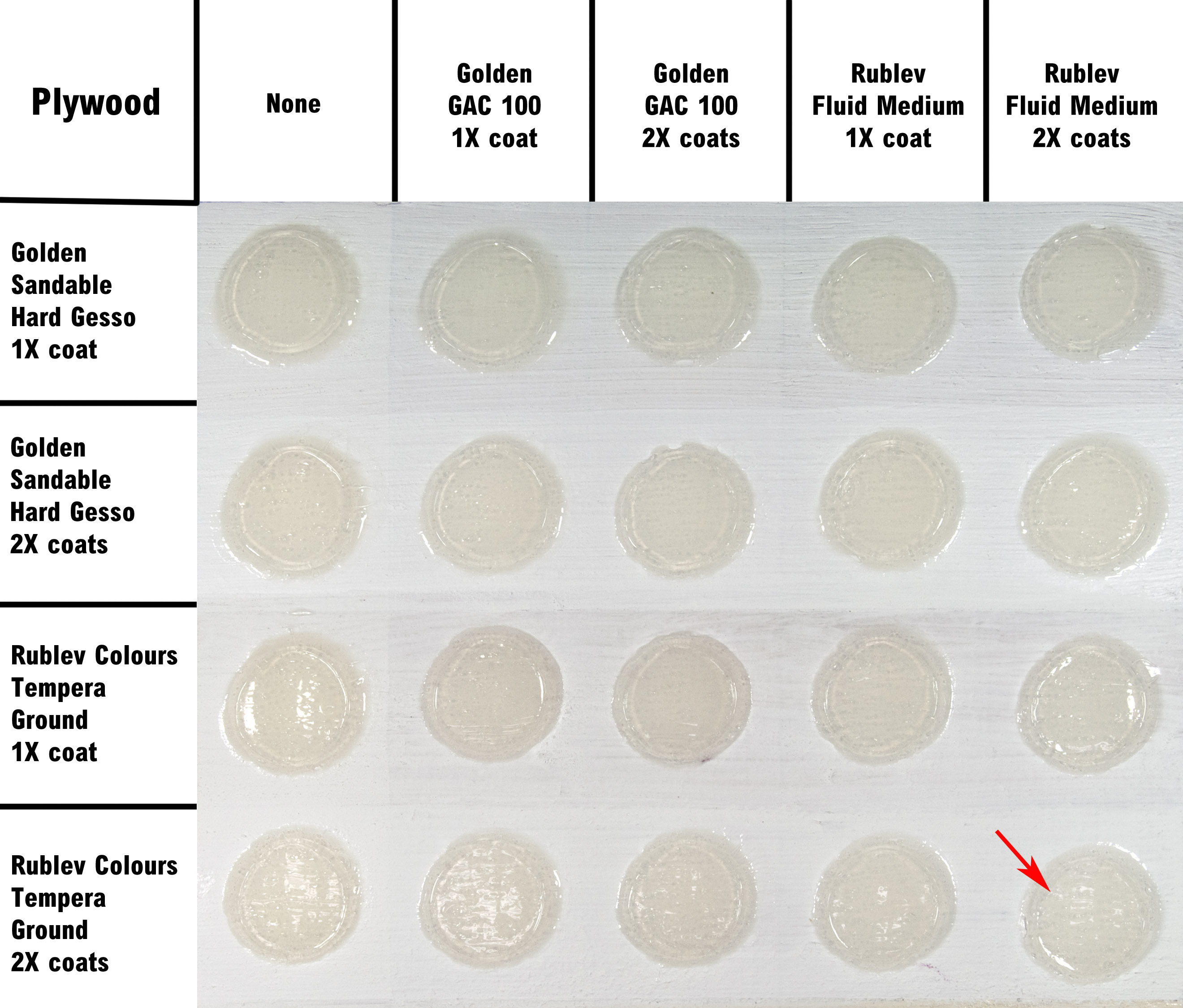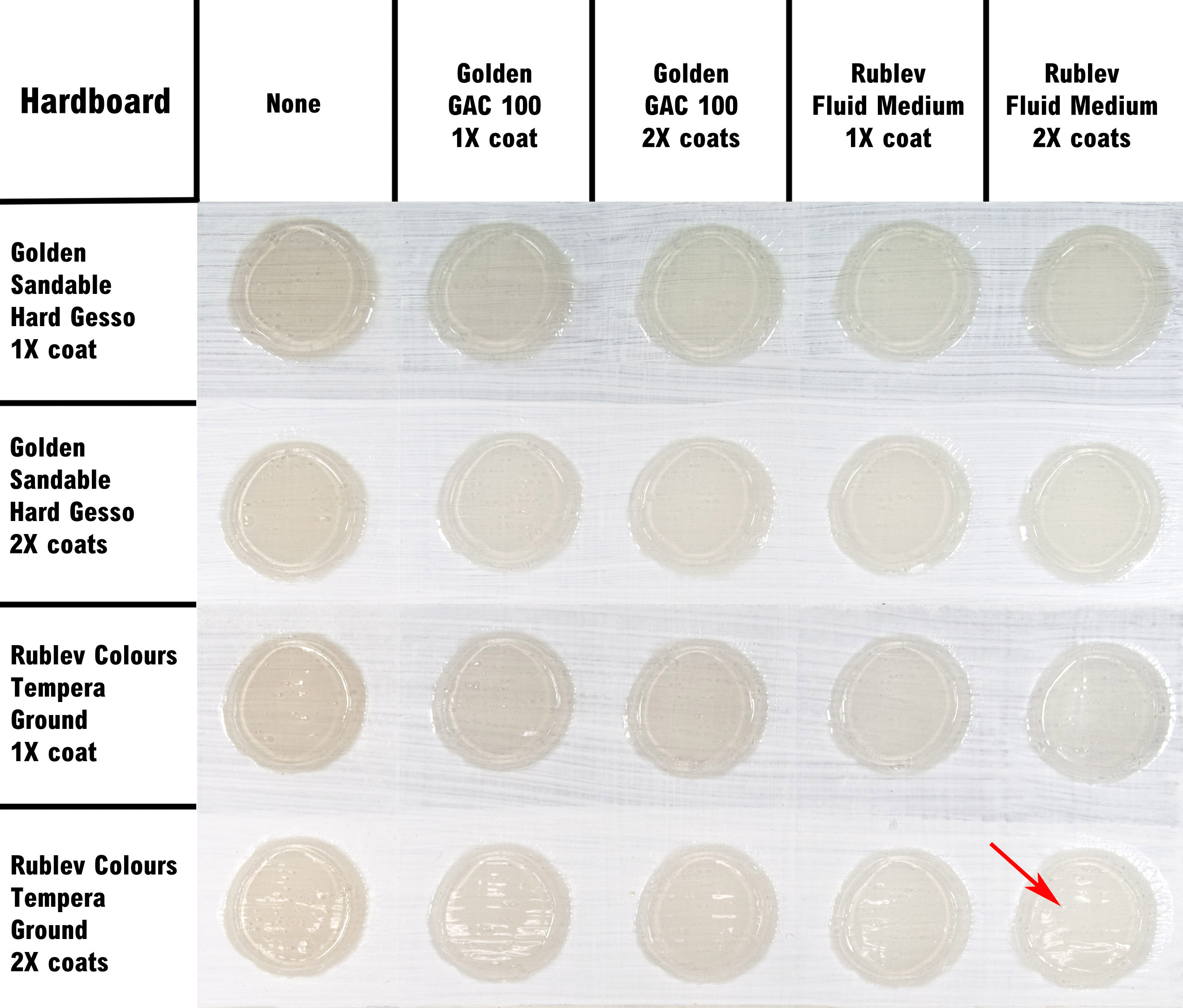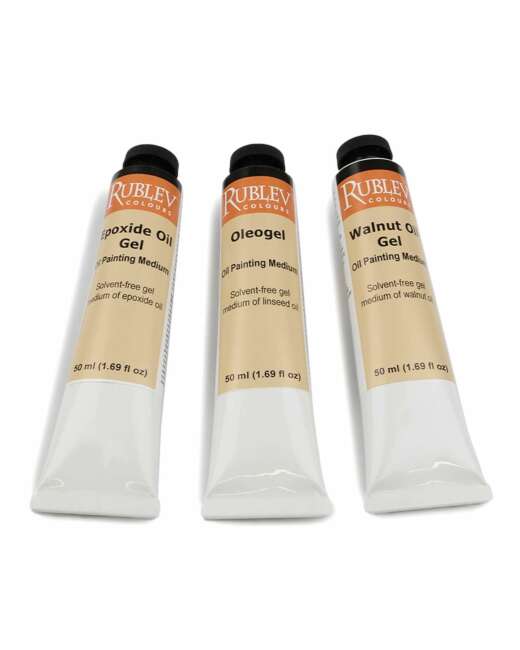
Water-borne artists’ acrylic paints and grounds (gesso) are highly permeable to water. Water penetration into these coatings is through diffusion—the movement of molecules from a region of high concentration to a region of low concentration. The rate by which water penetrates these films is at least ten times greater than water-borne sealer-primers and alkyd and epoxy paints formulated as water-barrier coatings. Water can penetrate a thin paint film within seconds and thicker films in minutes.[1] As water penetrates these coatings, it travels into the support underneath, transporting water-soluble substances from the support back into the acrylic media as it evaporates.
The transport of these discoloring compounds is clearly understandable since acrylic paint films can hold water for several hours as it is drying. Once these compounds are pulled into the paint layer, they permanently discolor the paint or media.

Discoloring of Water-Borne Artists’ Acrylic Paints
This phenomenon of yellowing or discoloring was first observed in water-borne artists’ acrylic paints in the early 1980s. An artist had observed the yellowing of Golden transparent acrylic medium in one of his paintings, prompting a joint research project between Golden Artist Colors, Inc. and the Buffalo State College Art Conservation Program. A variety of non-pigmented artists’ acrylic media were subjected to natural and accelerated aging. The discoloration was noticed in the samples applied to cotton and linen supports, more so than in those applied to glass. The discoloration appeared shortly after the samples had dried naturally. The discoloration was attributed to the migration of substances from the support into the acrylic medium during drying.[2] The water in the acrylic media traveled into the support, and colored substances within the support, such as glue, dirt, and degradation products, upon evaporation through the film, were transported back into the film.
Does Support-Induced Discoloration Occur with All Media?
Support-induced discoloration, or SID, occurs over a relatively brief period as the media is drying. The discoloration can occur in any acrylic media or gel brand but is most noticeable in unpigmented gels, matte, and gloss media. It can, however, also affect specific colored paint and incredibly transparent layers of blue.
Tests of other pigmented media, such as egg tempera, on traditional gesso, did not indicate support-induced discoloration to be a problem.[3] Because oil paint does not involve water, which transports discoloring compounds from the support, support-induced discoloration has not been observed in this medium.
What Supports Cause Discoloring of Paint Films?
The initial study of support-induced discoloration was done on linen and cotton canvas. Still, subsequent studies have shown that other porous supports, such as wood, can induce the discoloration of paint films.
To determine the potential for support-induced discoloration from wood supports, Natural Pigments tested three popular wood supports: medium-density fiberboard (MDF), plywood, and hardboard—all engineered wood products used by artists today. On three test panels (below), different coatings were applied in a grid to test the discoloration of an unpigmented acrylic gel (Golden Soft Gel—Gloss).
Golden Sandable Hard Gesso and Rublev Colours Tempera Grounds were tested on two grounds on each panel. The grounds were applied by brush across the panel in four horizontal bands as one and two coats over five vertical stripes on the wood panels. The first vertical band was applied directly to the bare surface of the wood panel, followed by two stripes of one and two coats of Golden GAC 100. One and two coats of Rublev Fluid Medium were applied in two vertical bands on the far right side of the panels. Both thin polymer mediums were each applied by brush.
These coatings were allowed to dry for three days. Golden Soft Gel—Gloss was then applied as quarter-inch thick discs through a circular stencil with a palette knife. The acrylic gels were allowed to dry completely for about one week.
As the acrylic gel dried, discoloration and yellowing were observed to various degrees in each disc. Acrylic gels on the MDF panel showed the most significant yellowing, with the most occurring in the gels on grounds applied directly to the panel.
Support-induced discoloration (SID) of the acrylic gel on medium-density fiberboard (MDF). The least amount of discoloration (shown by the red arrow) was observed with two coats of Rublev Fluid Medium applied on the MDF before applying Rublev Colours Tempera Ground.
Acrylic gels on the plywood panel showed the least yellowing, even in the gels on the grounds applied directly to the panel.
Support-induced discoloration (SID) of the acrylic gel on birch plywood. The least amount of discoloration (shown by the red arrow) was observed with two coats of Rublev Fluid Medium applied on the plywood before applying Rublev Colours Tempera Ground.
Yellowing was observed in the acrylic gels on the grounds applied directly to the hardboard panel. The acrylic gels on grounds that were applied over Golden GAC 100 and Rublev Fluid Medium showed little or no discoloration.
Support-induced discoloration (SID) of the acrylic gel on untempered hardboard. The least amount of discoloration (shown by the red arrow) was observed with two coats of Rublev Fluid Medium applied on the hardboard before applying Rublev Colours Tempera Ground.Conclusion
Medium-density fiberboard (MDF) induces a significant degree of yellowing in acrylic media, while plywood and hardboard panels give rise to slight or no yellowing. Coating or sealing the panel before applying a ground reduces or prevents the yellowing of acrylic media on wood panels. Rublev Colours Fluid Medium effectively reduced or eliminated support-induced discoloration on wood. Two thin coats of Rublev Fluid Medium were applied to the panel before applying the ground eliminated SID even on MDF.
Where to Buy Products
Disclaimer
The above information is based on research and testing done by Natural Pigments and is provided as a basis for understanding the potential uses of the products mentioned. Due to the numerous variables in methods, materials, and conditions of producing art, Natural Pigments cannot be sure the product will be right for you. Therefore, we urge product users to test each application to ensure all individual project requirements are met. While we believe the above information is accurate, WE MAKE NO EXPRESS OR IMPLIED WARRANTIES OF MERCHANTABILITY OR FITNESS FOR A PARTICULAR PURPOSE, and we shall in no event be liable for any damages (indirect, consequential, or otherwise) that may occur as a result of a product application.
References
1. Paul M. Whitmore, Hannah R. Morris and Val G. Colaluca, ‘Penetration of Liquid Water through Waterborne Acrylic Coatings’ in Modern Paints Uncovered: Proceedings from the Modern Paints Uncovered Symposium (2007) T. Learner (ed.) et al. Los Angeles: Getty Conservation Institute, pp. 217–223.
2. James Hamm, Ben Gavett, Mark Golden, James Hayes, C. Kelly, John Messinger, Margaret Contompasis and Bruce Suffield, ‘The Discoloration of Acrylic Dispersion Media’ in David Grattan (ed.) Saving the Twentieth Century: The Conservation of Modern Materials, Canadian Conservation Institute, Ottawa 1993, pp. 381–392.
















